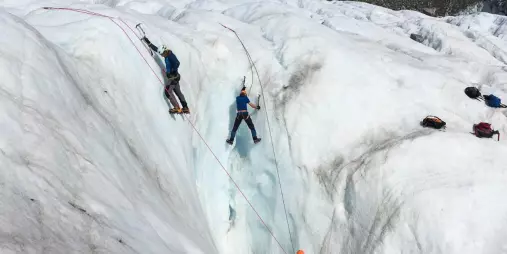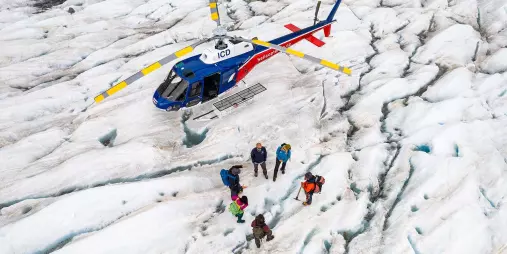A Family-Friendly Backcountry Experience
Designed for intermediate skiers and families alike, Ski the Tasman with Alpine Guides blends adventure with accessibility. With a minimum age of 10 and small group sizes, everyone gets the attention and space to enjoy their time on the snow. All safety gear and return transfers are included, making the day completely stress-free.
Beyond the thrill of skiing, this experience invites you to connect deeply with New Zealand’s alpine environment. You’ll glide past icy blue seracs, explore vast snowfields, and share stories over a picnic in the mountains. It’s a winter memory you’ll treasure for years to come.
INCLUSIONS
- Two of New Zealand’s longest ski runs, ranging from 8 to 10 km
- Three scenic helicopter flights
- Professional mountain guide services
- Generous picnic lunch on the snow
- Safety equipment, including avalanche transceivers
- Complimentary return airport transfers from accommodation in Mount Cook (if required)
- Lunch
AGE INFORMATION
- Minimum Age: 10
- All Children must be accompanied by at least one adult. A maximum of 2 children per adult.
CANCELLATIONS & REFUNDS
- More than 24 hours before departure: Full refund*
- Within 24 hours: No refund
Note: *Refunds exclude credit card or booking fees if applicable, which are non-refundable.
Please see more information on refunds and cancellations in Go New Zealand's terms and conditions.
- Check-In: 09:00 at the Alpine Guides base in Mount Cook Village.
- Group Size: A minimum of 3 people per group. Solo travellers and couples are welcome to book.
- Duration: Approximately 5 hours on the snow.
- Runs: The ski runs on the Tasman Glacier typically range from 8 to 10 km, though their length varies each season depending on snow cover.
If you can comfortably ski a blue run at a ski resort, you can ski the Tasman. The terrain is gentle and flowing, with a mix of open snowfields, deep bowls, and natural ice canyons formed between seracs.
This experience is ideal for those who ski just a few days a year, as long as they have a reasonable level of fitness. More advanced skiers will still appreciate the vast landscapes and the unique adventure this iconic glacier offers.
Reminders
- Dress for skiing (layers, warm accessories).
- Bring your own ski boots and poles (especially boots).
- Ensure skis are well-waxed (whether your own or rented elsewhere).
Gear Checklist
- Skis - at least 90mm wide underfoot.
- Ski goggles or quality sunglasses.
- Plenty of sunscreen.
- A small backpack with water, sunscreen, and a spare pair of gloves.
- Ski helmets are optional on the Tasman (no rocks).
Risk Disclosure - Ski The Tasman
Aircraft-accessed skiing is an adventure activity. Under New Zealand legislation we must advise you of the potential hazards involved - before you make a booking.
Our guides will identify, assess, eliminate, or minimise risks involved, so far as reasonably practicable, and you (the client) will follow the guide’s instructions at all times and understand that this is critical to your safety and that of the group.
If you have any concerns or require further information, do not hesitate to contact us. Safety is paramount, and we are committed to addressing any queries you may have.
Weather Conditions: The unpredictable nature of mountain weather means changes can occur rapidly, affecting visibility, snow conditions, and aviation safety. Our guides and pilots constantly monitor weather patterns to make informed decisions regarding your safety.
Glaciated Alpine Terrain: The terrain in alpine environments includes, but without being exhaustive, things such as falling rocks, cliffs, ice cliffs, crevasses, cornices, avalanches, changing snow conditions, steep slopes, loose rocks, and icy surfaces. Crevasse fall is the main danger on the Tasman Glacier. It is crucial to follow your guides’ instructions, use proper equipment, and maintain focus to avoid potential falls or slips that may lead to serious or fatal injuries.
Avalanches: Ski The Tasman takes place on uncontrolled natural snow surfaces. Most of the guided ski terrain has a low exposure to avalanches. Although our guides assess avalanche risk and thoroughly plan each day’s run selection, there is still an inherent danger. Our guides are trained in avalanche safety and will take every precaution to minimize risks and provide guidance to clients. Avalanches can cause severe injuries, burials, or fatalities.
Physical and Medical Fitness: It is crucial to inform your guide of any existing medical conditions that may affect your participation. All participants should be proficient skiers with a moderate level of aerobic fitness. Snow conditions are variable.
Piloting and Helicopter Safety: Our pilots are experienced in mountain flying. However, flying in mountainous terrain adds risks due to unique weather patterns. Aircraft are regularly inspected and maintained to Civil Aviation Authority standards.
Emergency Situations: While every precaution is taken to ensure safety, unavoidable emergencies can arise. In such instances, our guides are trained to handle emergencies and will provide prompt medical attention or evacuation, prioritizing your well-being. Escaping the mountain environment or communicating with external emergency support may be delayed.
Natural Disasters: The Southern Alps sit on the Alpine Fault. Natural disasters such as earthquakes can occur without warning.






